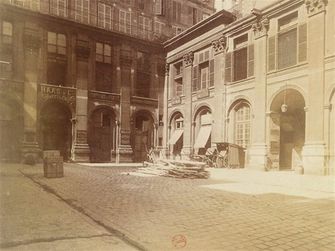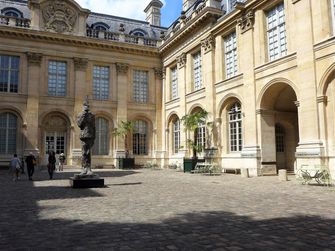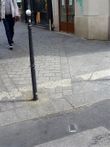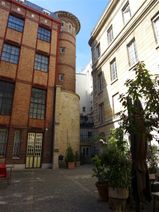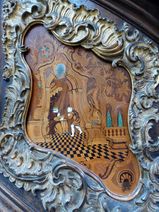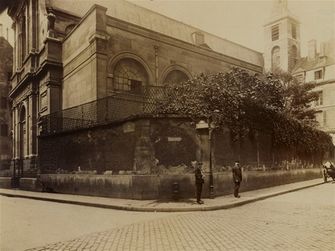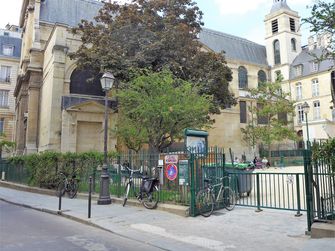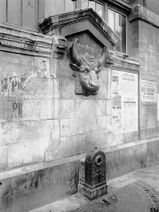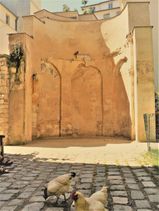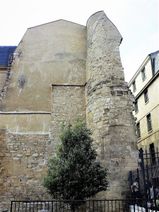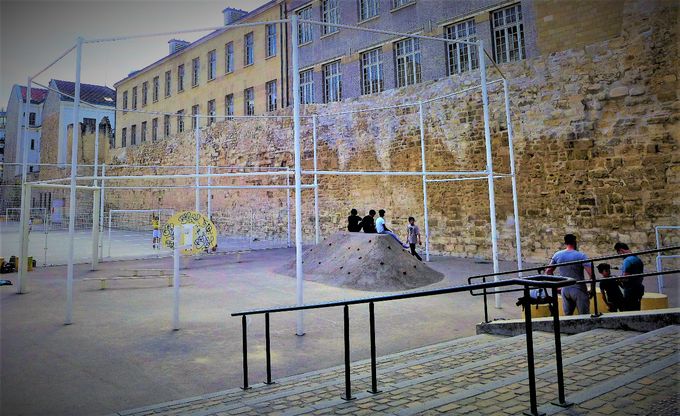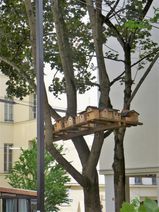Hora fugit - Un peu de Paris
Wall Philip II in Marais
.
.
Rue du Temple
Let's now follow rue Saint-Denis down toward rue Rambuteau that we take on our left. Let’s continue up to rue du Temple, where we will stop at the Musee d’Art et d'Histoire du Judaïsme (Museum of Jewish Art and History).
Now, have a close look at the left wing of the mansion. Something I admit I had never really done on my previous visits to the museum. At first glance, the wing with its high windows is in perfect harmony with the two others. However, there is a strange feeling, the facade seems too close with the buildings behind.
No wonder, the facade is a trompe-l'oeil. A false facade with false windows, against a remnant of the wall of Philip Augustus.
This elegant mansion built by Claude de Mesmes in 1644 was subsequently damaged during the 18th and 19th centuries. Atget took a photo of it in 1901. Divided into commercial and industrial premises with additional storeys, it was quite damaged. Fully restored, it has now regained all of its former elegance.
Hôtel Claude de Mesmes – 1650
71, rue du Temple
Atget – 1901/1902
(BnF)
From rue Rambuteau to rue des Francs Bourgeois
Let's go back rue Rambuteau.
When you arrive by numbers 3 and 5 of the street, look at the big marks on the pavement and the road. No doubt, (I have checked it) they follow the layout of the wall!
Difficult for the few passers-by, I should say rather the wall-passers, to understand my excitement when I discovered these.
Rue des Francs Bourgeois - Crédit Municipal
Let's continue along the rue des Francs-Bourgeois, where we will stop at no. 55 to enter the courtyard of the Credit Municipal, an old money-lending institution.
Follow the line on the ground, marking the layout of the wall of Philip Augustus. At the end of the second small courtyard, you will see a pink brick tower. Its base is the remains of a wall tower discovered in 1879.
Quite an unpleasant discovery for the architect in charge of new buildings for the Crédit Municipal. Unsuccessful to have it demolished, he had it topped with a second brick tower in the same style as the new building!
Church of Notre Dame des Blancs-Manteaux
Let's continue along the rue des Francs-Bourgeois and enter the church of Notre Dame des Blancs Manteaux. Its splendid pulpit will deserve your attention.
Let's exit the church by the rue des Blancs Manteaux and turn left.
The wall of Philippe Augustus was crossing the space occupied today by the choir of the church and by the public garden toward the today rue du Marché des Blancs-Manteaux.
When Atget took the photo, the rue des Guillemites extended to the rue des Francs-Bourgeois and the public garden did no exist yet. It was created later in the 1960s.
At the intersection of rue du Marché des Blancs-Manteaux with rue Vieille du Temple, we meet again with John the Fearless … this is here that his men murdered the King’s brother, the Duc d'Orléans.
Church of Notre-Dame des Blancs-Manteaux
Corner rue des Guillemites and rue des Blancs-Manteaux
Atget - (Musée Carnavalet)
Rue des Hospitalières Saint-Gervais
Let's continue up to rue des Hospitalières Saint-Gervais where the wall of Philip Augustus is stretching across the present left side of the school.
In the 19th century, the current building of the school was occupied by a meat market. This explains the presence of the two imposing bronze ox heads fountains.
Here, I cannot help thinking of some Apollinaire’s verses inspired for another reason. All these plaques in memory of the deported children, are “suppurated fiery wounds, Of mist and blood all the facades in lamentation cry aloud”. From these Assyrian heads no longer flow “the white Canaan rills”. For here has always floated the Song of the Unloved.
Ox head fountain – Blancs Manteaux Market
6, rue des Hospitalières Saint-Gervais
Atget - 1906
(Médiathèque Architecture et Patrimoine)
In 1182, Philip Augustus expelled the Jewish community from Paris and confiscated all their goods. Several years later, he readmitted the Jews with a strict regulation of their financial business. When they returned, the Jews settled in the rue des Rosiers and rue des Ecouffes, forming the Jewish neighborhood, the same spot after every exile over the centuries.
Let's now continue toward rue des Rosiers where we will turn left. We enter the small public garden of Les Rosiers-Joseph Migneret. Its name is in tribute to the courageous director of the school rue des Hospitalières Saint-Gervais that we just left. Joseph Migneret saved many Jewish children from deportation and is Righteous Among the Nations. At the entrance of the garden, the memorial plaque for the infant victims of the holocaust, not yet school aged, is devastating; some of them were babies.
Jardin des Rosiers - Joseph Migneret
This lovely garden is composed of the former private gardens belonging to the three mansions, hotels d'Albret, Barbes and de Coulanges.
I remember my mother telling me about it when it was created in the 2000s. She was one of the few to enjoy this cute and very quiet garden as it was then very little known.
There is a tower of the wall of Philip Augustus, still visible at the entrance of the garden. The decorations inside the tower were created afterwards when the tower, located in the former private garden of the Hôtel d’Albret was converted into a summer dining room and later into a chapel.
Rue Mahler
After this nice break, personally I could stay here for hours, let's go out to the left onto Rue des Rosiers. Let’s take rue Pavée to the left up to the intersection with rue Mahler.
The vestige here has nothing to do with the wall of Philip Augustus. It is the only remains of La Force prison built in 1780 on the site of a former private residence of duc de La Force. During the French Revolution, more than one hundred and fifty people were executed there in three days of September 1792. Among them, Marie-Antoinette’s friend, the Princesse de Lamballe, who met a very violent end.
The prison was demolished in 1851 and the present rue Mahler took its place.
Wall of the former la Petite Force prison (demolished)
Atget - (Musée Carnavalet)
Rue Saint-Antoine - Rue du Prévôt - Rue Charlemagne
We are now rue Saint-Antoine. Between n°101 and 103 stood one of the most important fortified gates of the wall, heading to Meaux and Sens, two important cities. The medieval rue Saint-Antoine between the Louvre and this gate is still narrow. Beyond this point, the street becomes much wider as it was later opened across spaces outside the city.
Let's cross the street to take the narrow medieval rue du Prévôt and turn left onto rue Charlemagne.
Just before the rue des Jardins-Saint-Paul, where are the longest remains of the wall, there is the Montgomery tower. Part of the wall, it gets its name from Gabriel, comte de Montgomery, remembered for mortally wounding King Henry II in a jousting accident in 1559, in rue Saint-Antoine. For a short time after the accident, he was imprisoned in what became the Montgomery tower.
Rue des Jardins Saint-Paul
The wall now visible between Rue Charlemagne and Rue de l'Ave-Maria was incorporated in the Ave-Maria convent. It reappeared when the houses built on the outer side of the wall were demolished in 1946. The photograph taken by Atget show these buildings on the left side of the street. The area left vacant is today used as a sports ground for the students of the Lycée Charlemagne, along the longest and best preserved remnant of the wall.
Rue des Jardins-saint-Paul
At the back, rue Charlemagne and Church of Saint-Paul Saint-Louis
Atget - (Musée Carnavalet)
Have a look at the courtyards of the Village Saint-Paul, where there are some antique dealers, open during weekends.
The wall continued up to the Seine in front of the Île Saint-Louis, where the Tour Barbeau was standing over the river. From there, heavy chains were linked to the Tournelle on the Left Bank, across the river and Ile-Saint-Louis, then inhabited and two natural islands at that time.
Last part of the stroll - From the Ile Saint-Louis to the Pont des Arts
Texte / Photos : Martine Combes
Contact / newsletter:
